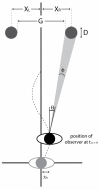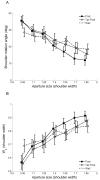Static and dynamic visual information about the size and passability of an aperture
- PMID: 22132505
- PMCID: PMC3420977
- DOI: 10.1068/p6917
Static and dynamic visual information about the size and passability of an aperture
Abstract
The role of static eyeheight-scaled information in perceiving the passability of and guiding locomotion through apertures is well established. However, eyeheight-scaled information is not the only source of visual information about size and passability. In this study we tested the sufficiency of two other sources of information, both of which are available only to moving observers (ie are dynamic) and specify aperture size in intrinsic body-scaled units. The experiment was conducted in an immersive virtual environment that was monocularly viewed through a head-mounted display. Subjects walked through narrow openings between obstacles, rotating their shoulders as necessary, while head and shoulder position were tracked. The task was performed in three virtual environments that differed in terms of the availability of eyeheight-scaled information and the two dynamic sources of information. Analyses focused on the timing and amplitude of shoulder rotation as subjects walked through apertures, as well as walking speed and the number of collisions. Subjects successfully timed and appropriately scaled the amplitude of shoulder rotation to fit through apertures in all three conditions. These findings suggest that visual information other than eyeheight-scaled information can be used to guide locomotion through apertures.
Figures










Similar articles
-
Visual guidance of walking through apertures: body-scaled information for affordances.J Exp Psychol Hum Percept Perform. 1987 Aug;13(3):371-83. doi: 10.1037//0096-1523.13.3.371. J Exp Psychol Hum Percept Perform. 1987. PMID: 2958586
-
Does the passability of apertures change when walking through human versus pole obstacles?Acta Psychol (Amst). 2015 Nov;162:62-8. doi: 10.1016/j.actpsy.2015.10.007. Epub 2015 Oct 31. Acta Psychol (Amst). 2015. PMID: 26529484
-
Virtual auditory aperture passability.Exp Brain Res. 2019 Jan;237(1):191-200. doi: 10.1007/s00221-018-5407-z. Epub 2018 Oct 29. Exp Brain Res. 2019. PMID: 30374783
-
Sensory substitution information informs locomotor adjustments when walking through apertures.Exp Brain Res. 2014 Mar;232(3):975-84. doi: 10.1007/s00221-013-3809-5. Epub 2013 Dec 27. Exp Brain Res. 2014. PMID: 24370580
-
Optic flow and the visual guidance of locomotion in the cat.Int Rev Neurobiol. 2000;44:141-70. doi: 10.1016/s0074-7742(08)60741-2. Int Rev Neurobiol. 2000. PMID: 10605645 Review. No abstract available.
Cited by
-
Discovering your inner Gibson: reconciling action-specific and ecological approaches to perception-action.Psychon Bull Rev. 2014 Dec;21(6):1353-70. doi: 10.3758/s13423-014-0623-4. Psychon Bull Rev. 2014. PMID: 24683098 Review.
-
Gut estimates: Pregnant women adapt to changing possibilities for squeezing through doorways.Atten Percept Psychophys. 2014 Feb;76(2):460-72. doi: 10.3758/s13414-013-0578-y. Atten Percept Psychophys. 2014. PMID: 24338434 Free PMC article. Clinical Trial.
-
Information and control strategy to solve the degrees-of-freedom problem for nested locomotion-to-reach.Exp Brain Res. 2014 Dec;232(12):3821-31. doi: 10.1007/s00221-014-4072-0. Epub 2014 Aug 22. Exp Brain Res. 2014. PMID: 25146573
-
Female mate choice in convict cichlids is transitive and consistent with a self-referent directional preference.Front Zool. 2013 Nov 11;10(1):69. doi: 10.1186/1742-9994-10-69. Front Zool. 2013. PMID: 24216003 Free PMC article.
-
Self body-size perception in an insect.Naturwissenschaften. 2013 May;100(5):479-84. doi: 10.1007/s00114-013-1042-5. Epub 2013 Apr 24. Naturwissenschaften. 2013. PMID: 23612986
References
-
- Arzamarski R, Harrison SJ, Hajnal A, Michaels CF. Lateral ball interception: hand movements during linear ball trajectories. Experimental Brain Research. 2007;177(3):312–323. doi: 10.1007/s00221-006-0671-8. - PubMed
-
- Bootsma RJ. Predictive information and the control of action: What you see is what you get. International Journal of Sports Psychology. 1991;22:271–278.
-
- Chang CH, Wade MG, Stoffregen TA. Perceiving Affordances for Aperture Passage in an Environment-Person-Person System. Journal of Motor Behavior. 2009;41(6):495–500. - PubMed
-
- Di Luca M. New method to measure end-to-end delay of virtual reality. Presence: Teleoperators and Virtual Environments. 2010;19(6):569–584.
-
- Duchon AP, Warren WH., Jr. A visual equalization strategy for locomotor control: of honeybees, robots, and humans. Psychological Science. 2002;13(3):272–278. - PubMed
Publication types
MeSH terms
Grants and funding
LinkOut - more resources
Full Text Sources

